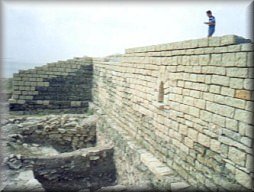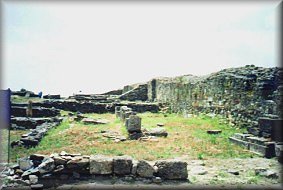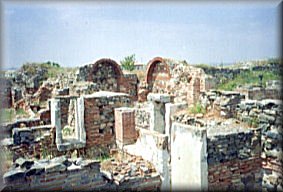
Again we woke up very early in the morning, and we went to meet Mr. Zahariade and the EARTHWATCH team members, and together we left for the Argamum fortress, which is located near Razelm, a lake that used to be a gulf.

The fortress was built by the Greeks
and was later rebuilt by the Romans in the 1st century A.D.
Argamum is thought to have a total area of approximately 30,000 square
meters, but 1/3 of it is situated beneath lake Razelm and parts of the
ruins can only be seen when the water level is very low. Inside we saw
three Christian basilicas and two towers that used to be 10m high; they
were later transformed in ovens. Unfortunately, because of the bad weather
we couldn't shoot any of the things we saw. Anyway, we left Argamum
and headed for Histria.
The city of Histria - the
first Greek colony on the west shore of Pontus
Euxinus and the oldest city on the territory of our country - is
on the border of lake Sinoe, "at a distance of 500 stadia from the
sacred mouth of Istros", as Strabo noted. (The 'Istros' is the modern-day Danube.)
Being founded by the middle of the 7th century B.C., during the Olympic
Games (675 b.c), after Eusebius, -or during the last decades of the same
century- by the colonists of Milet, Histria has had a continuous
development, both during the Greek and the Roman period, representing for
a long time the most important economic and cultural centre in Dobrogea.


Due to Vasile Parvan's efforts between
1914-1916 and 1921-1926, the research at Histria meant the discovery
of the entire large wall of the city, as well as of a great number of public
and private buildings, most of them dated in the 4th-7th
century a.d. Among them were the district on the west side of the city,
the trade building, the market with a portico, the thermae, and also of
numerous inscriptions which offered a suggestive image of the city development.
It has 6 precincts: archaic, classical,
Hellenistic, Roman, Byzantine and sector X. It is conventionally named
X evidence of intense inhabitation appeared (house reminders and holes
with a rich ceramics material).
On our way to Navodari,
where we were hosted in complex Victoria, we sang and played whist. In
Navodari we phoned our parents and in the evening we took a walk
on the shore.
And that was the end of the 3rd
day.